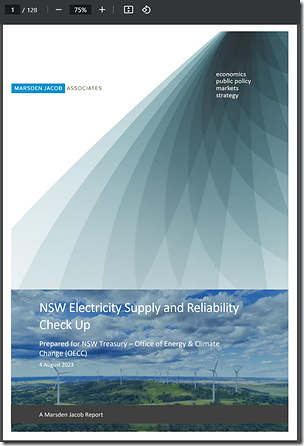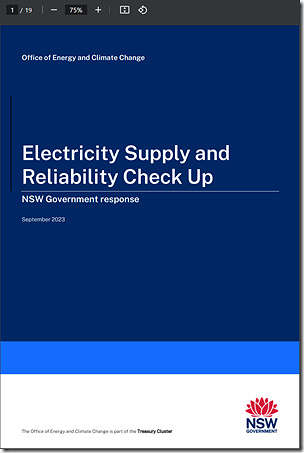Last week (just prior to the AEMO’s release of the 2023 ESOO), I wrote about ‘Reports of recommendations to consider extending the life of Eraring Power Station’ … and shortly afterwards noted how ’The 2023 ESOO again prompts the question … ‘what’s the contingency plan’?’ (with the extension to the life of Eraring Power Station being one of those).
So the news yesterday was not really a surprise, when the NSW Government released both the Marsden Jacob report and the Government’s Response to this. Readers here can access both of these reports, as follows:
| The MJA Report
‘NSW Electricity Supply and Reliability Check Up’ |
Response
‘Electricity Supply and Reliability Check Up – NSW Government Response’ |
|---|---|
|
You can download the 128-page PDF of the MJA report here:
|
You can download the 19-page PDF of the Government Response here: |
|
What particularly jumped out at me, in a very quick initial review, was the following (at p12/128) … ‘Some have argued that the potential 2025 closure of Eraring requires the state to speed up the infrastructure build. Given the multiple headwinds, the likelihood of success is low. The cost to consumers could be high. Long-term social license in the REZs could be jeopardised. In other sectors, building infrastructure in 3.5 years to replace a critical asset would not be possible. If there was a projected water shortage, a new desalination plant could not be commissioned in such a timeframe. With the amount of notice given on Eraring’s closure, it is reasonable to seek more Even with an extension to Eraring, a more multi-faceted approach to managing NSW’s electricity supply and reliability in the current decade is required. It will involve a minor pivot, while remaining committed to the Roadmap ambition and targets. The key to the successful management of electricity supply and reliability is a better alignment of capacity exit and entry. This is also critical to achieving affordability and reliability objectives. Electricity policy is a balance between emissions reduction, affordability and reliability. A trilemma.’
|
What particularly jumped out at me, in a very quick initial review, was the following… ‘The Check Up makes clear that Origin Energy has a strong commercial interest to defer the closure of Eraring. Eraring is a profitable asset and has a decade left of its technical life. Origin Energy has a very large existing retail customer base it cannot yet supply without Eraring (p7,8/19) … and … ‘A decision by Origin to temporarily extend its timeline for phasing out Eraring could provide NSW with a buffer to manage these risks. However, this is only one solution and the NSW Government has other options to mitigate these risks if required.’ (p8/19) … and … ‘Appreciating that NSW has a privatised energy market, the NSW Government will engage with Origin Energy to clarify its plans for Eraring.’ (p8/19) See Nos 20, 21, 22, 23, 24 and 25 in the table at the end for more details. |
(A) News Media commentary about this
So far today I have come across commentary in a range of places, including the following:
1) Here on WattClarity®:
(a) There’s this note, obviously
2) In the AFR I have seen…
(a) Samantha Hutchinson and Angela MacDonald-Smith write ‘NSW admits it needs coal-fired power for longer’ ; and
(b) Angela MacDonald-Smith wrote the Opinion piece ‘Still at square one, but a state deal on Eraring is now inevitable’.
(c) Did not see anything else in a quick scan
3) In the Australian I have seen…
(a) Colin Packham wrote ‘Coal plant in Eraring to stay open longer: NSW government’ ; and
(b) Did not see anything else in a quick scan
4) In RenewEconomy I have seen…
(a) Giles Parkinson wrote ‘NSW to fast track new wind and solar as it opens talks on Eraring closure timing’ ; and
(b) Did not see anything else in a quick scan
5) In the Guardian I have seen …
(a) Peter Hannam and Catie McLeod wrote ‘NSW to enter talks to extend life of Eraring, Australia’s largest coal-fired power station’ ; and
(b) Did not see anything else in a quick scan
6) In the ABC I have seen …
(a) Isobel Roe wrote ‘Review recommends NSW government delay closure of Eraring power station’ ; and
(b) Did not see anything else in a quick scan
I’ve not had time to scan widely, but readers might add other references below if they come across them.
(B) Social Media commentary
So far today I have come across commentary in a range of places, including the following:
1) On LinkedIn here on Tue 8th Sept, Penny Sharpe (NSW Minister for Energy etc) posted these comments:
‘The NSW Government has released the Electricity Supply and Reliability Check Up and its strategy to secure the reliable supply of clean, affordable, renewable energy for NSW.
The Check Up makes 54 recommendations to keep the Electricity Infrastructure Roadmap on track. The Government has accepted 50 recommendations; 44 in full, another three in part and three are already underway or complete.
In light of the Check Up’s findings and recommendations, the NSW Government will take action in three key areas.
Firstly, delivery of the Roadmap will become a strategic priority of the NSW Government. This will bring with it a whole of government effort to make sure that as coal-fired power retires, NSW households and businesses have enough renewable energy, transmission and storage to replace it as quickly as possible.
Secondly, the NSW Government, through its Energy Security Target Monitor, will more actively scrutinise the plans of NSW’s remaining private coal-fired power stations as they approach retirement.
Finally, the NSW Government will streamline renewables approvals in the planning system as well as enhance and coordinate community benefit sharing. We will unlock opportunities to connect new renewables to the existing grid outside of the REZs. And we will develop a strategy to unleash the potential of households and businesses to further embrace small-scale renewables like solar in the short-term, without shifting focus and momentum from the delivery of large-scale projects.
The transition to renewables is an exciting opportunity for NSW communities and the economy. We’re getting on with it.’
… but this does make one wonder why were these actions not taken beforehand?
2) On Tue 5th Sept 2023, the Australian Energy Council wrote ‘NSW Electricity Check Up Highlights Challenges of Transition’.
3) The EUAA noted that ‘NSW Electricity Check Up Sets Out Practical Actions To Meet Transition Goals With A Consumer Focus’ on Wed 6th September 2023.
I’ve not had time to scan widely, but readers might add other references below if they come across them.




Leave a comment